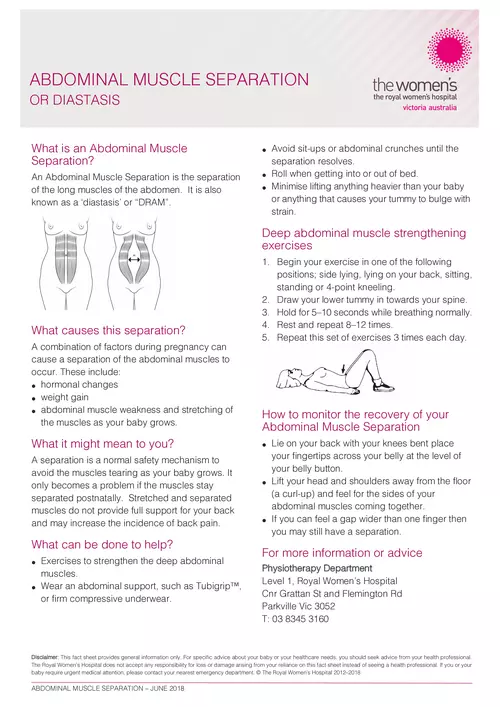
abdominal muscle separation - or diastasis - The Royal Women's
reducing by six weeks. They can help advise you on the exercises to avoid and suggest those that will help close the abdominal muscle gap.
adsPart of the document
Disclaimer: This fact sheet provides general information only. For specific advice about your baby or your healthcare needs, you should seek advice from your health professional.
The Royal Women's Hospital does not accept any responsibility for loss or damage arising from your reliance on this fact sheet instead of seeing a health professional. If you or your
baby require urgent medical attention, please contact your nearest emergency department. © The Royal Women's Hospital 2012-2018
ABDOMINAL MUSCLE SEPARATION - JUNE 2018
What is an Abdominal Muscle
Separation?
An Abdominal Muscle Separation is the separation
of the long muscles of the abdomen. It is also
known as a 'diastasis' or "DRAM".
What causes this separation?
A combination of factors during pregnancy can
cause a separation of the abdominal muscles to
occur. These include:
•
hormonal changes
•
weight gain
•
abdominal muscle weakness and stretching of
the muscles as your baby grows.
What it might mean to you?
A separation is a normal safety mechanism to
avoid the muscles tearing as your baby grows. It
only becomes a problem if the muscles stay
separated postnatally. Stretched and separated
muscles do not provide full support for your back
and may increase the incidence of back pain.
What can be done to help?
•
Exercises to strengthen the deep abdominal
muscles.
•
Wear an abdominal support, such as Tubigrip™,
or firm compressive underwear.
•
Avoid sit-ups or abdominal crunches until the
separation resolves.
•
Roll when getting into or out of bed.
•
Minimise lifting anything heavier than your baby
or anything that causes your tummy to bulge with
strain.
Deep abdominal muscle strengthening
exercises
1.
Begin your exercise in one of the following
positions; side lying, lying on your back, sitting,
standing or 4-point kneeling.
2.
Draw your lower tummy in towards your spine.
3.
Hold for 5-10 seconds while breathing normally.
4.
Rest and repeat 8-12 times.
5.
Repeat this set of exercises 3 times each day.
How to monitor the recovery of your
Abdominal Muscle Separation
•
Lie on your back with your knees bent place
your fingertips across your belly at the level of
your belly button.
•
Lift your head and shoulders away from the floor
(a curl-up) and feel for the sides of your
abdominal muscles coming together.
•
If you can feel a gap wider than one finger then
you may still have a separation.
For more information or advice
Physiotherapy Department
Level 1, Royal Women's Hospital
Cnr Grattan St and Flemington Rd
Parkville Vic 3052
T: 03 8345 3160
ABDOMINAL MUSCLE SEPARATION
OR DIASTASIS


